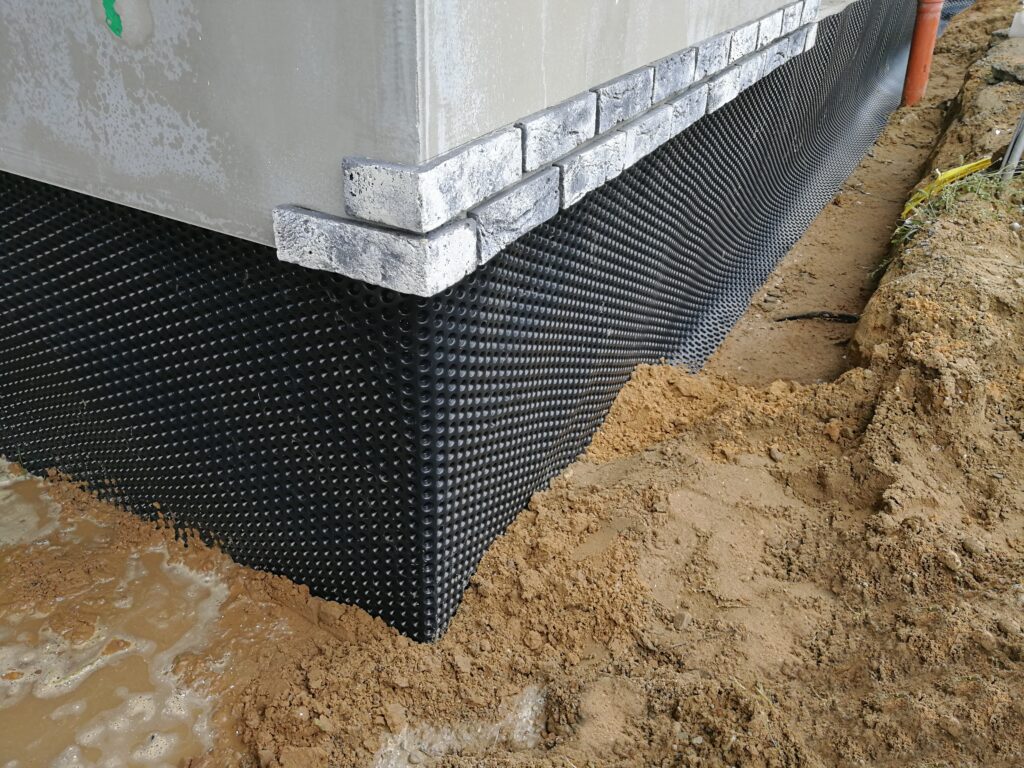Foundation Protection: Preventing Water Damage Before Winter
As the chill of November sets in and rain—or even snow—begins to fall, your home’s foundation faces one of its biggest threats of the year: water damage.
Whether from heavy rainfall, melting snow, or clogged gutters, excess moisture around your foundation can lead to serious and costly problems. Over time, poor drainage causes cracks, structural shifting, and even opens the door for rodents seeking shelter from the cold.
Fortunately, with the right foundation protection plan and seasonal maintenance, you can safeguard your home before winter weather sets in. This guide will walk you through how water damages foundations, why prevention is key, and what practical steps you can take right now to keep your foundation dry, stable, and strong.
Why Water Damage Is So Dangerous for Your Foundation
Water may seem harmless, but when it collects around your foundation, it becomes one of the most destructive forces affecting your home. Over time, excess moisture leads to foundation cracking, soil erosion, and interior water seepage—all of which compromise structural integrity.
Here’s what happens when drainage systems fail:
🌧 1. Soil Expansion and Contraction
Most foundations sit on clay or loamy soil that naturally expands when wet and contracts when dry. If water consistently pools around your home, the soil swells and pushes against the foundation walls. Once it dries, it contracts again, creating gaps that cause your foundation to shift or crack.
🧱 2. Hydrostatic Pressure
When heavy rain or melting snow saturates the ground, hydrostatic pressure builds up against the walls of your foundation. This pressure forces water into small cracks and seams, eventually leading to leaks in basements or crawl spaces.
💧 3. Freeze-Thaw Damage
In colder climates, trapped water in foundation cracks freezes and expands, widening the damage. Over time, this cycle weakens the concrete, allowing even more moisture to enter—and pests to follow.
🐭 4. Rodent Access
Rodents often exploit water-related damage. A small crack or gap caused by water erosion becomes an easy entry point for mice and rats. Once inside, they can cause extensive structural and electrical damage.
By the time you see visible cracks or standing water, the problem may already be significant. The best approach is proactive foundation protection and drainage management before winter weather takes hold.
Signs Your Foundation Is at Risk of Water Damage
A foundation problem doesn’t happen overnight. It develops slowly, often showing subtle signs that many homeowners overlook. Here’s what to watch for:
- Cracks in foundation walls or floors
- Damp or musty smells in basements or crawl spaces
- Water stains or efflorescence (white mineral buildup) on concrete
- Pooled water near your home after rainfall
- Uneven or sloping floors
- Gaps around doors and windows
- Mold or mildew growth in lower levels
If you notice any of these warning signs, it’s time to inspect your drainage system and take preventive action before freezing temperatures worsen the issue.
Step 1: Inspect and Maintain Your Drainage System
The first line of defense for your foundation is an efficient drainage system that directs water away from your home. Without it, even a light rain can create lasting damage.
✅ Check Gutters and Downspouts
- Clear gutters of leaves, dirt, and debris at least twice a year (especially in fall).
- Make sure downspouts extend 4–6 feet away from your foundation.
- Consider adding gutter extensions or splash blocks to improve runoff direction.
✅ Inspect Grading Around Your Home
Your yard should slope away from your foundation at a rate of at least 6 inches over 10 feet. Over time, soil settles and loses its slope, allowing water to pool near the base of your home.
- Add topsoil or fill dirt to reestablish proper grading.
- Avoid using mulch directly against the foundation—it retains moisture.
✅ Install or Maintain French Drains
A French drain system collects and redirects groundwater before it can pool near your foundation. It consists of a gravel trench and perforated pipe that channels water away safely.
- Inspect your French drain for clogs or blockages.
- If you don’t have one, consider installation before winter rains intensify.
Step 2: Add a Sump Pump for Extra Protection
For homes in areas prone to heavy rainfall, a sump pump is a must-have addition. This device automatically removes water that accumulates in basements or crawl spaces, keeping them dry year-round.
🔧 How It Works
A sump pump sits in a pit (the sump basin) at the lowest point of your crawl space or basement. When water fills the pit, a float switch triggers the pump, which then redirects the water through a discharge pipe away from your foundation.
💡 Maintenance Tips
- Test your pump before winter by pouring water into the pit—it should start automatically.
- Clean debris from the sump basin regularly.
- Check the discharge line to ensure it’s clear of ice or blockages.
- Consider a battery backup system in case of power outages during storms.
Combining a sump pump with proper grading and a French drain system provides the most effective protection against flooding and foundation water damage.
Step 3: Seal Foundation Cracks and Vulnerable Areas
Even small cracks can allow water intrusion that leads to structural damage over time. Before winter, inspect your foundation thoroughly and repair any visible flaws.
🧱 Seal Small Cracks
Use hydraulic cement or epoxy sealants to fill cracks and prevent moisture infiltration. These materials expand as they cure, sealing even hairline openings.
🧰 Waterproof Basement Walls
For long-term protection, apply a waterproof coating or membrane to basement or crawl space walls. This barrier prevents moisture from seeping through porous concrete during heavy rain or snowmelt.
🪟 Check Doors, Windows, and Vents
Ensure all openings near the foundation—such as crawl space vents or basement windows—are sealed and weatherproofed. Install metal mesh over vents to block rodents without restricting airflow.
Step 4: Control Interior Moisture Levels
While outdoor drainage is crucial, indoor humidity also contributes to water damage. High moisture levels inside your crawl space or basement can cause wood rot, mold, and condensation that compromise structural integrity.
🌡 Use Dehumidifiers
Keep relative humidity between 40–50%. Crawl space or whole-home dehumidifiers are excellent for year-round moisture management.
💨 Improve Ventilation
Ensure vents are open and unobstructed to allow air circulation. Consider adding mechanical ventilation or exhaust fans if natural airflow is limited.
⚙️ Install Vapor Barriers
Cover the ground in crawl spaces with a durable vapor barrier (minimum 6-mil plastic sheeting). This prevents ground moisture from evaporating upward and condensing on wood or insulation.
Step 5: Schedule a Professional Foundation Inspection
Even if your home appears to be in good shape, a professional inspection can uncover hidden issues. Experts use specialized tools to detect:
- Water seepage behind foundation walls
- Subtle soil movement
- Signs of structural stress
- Early indicators of rodent or termite activity
A qualified contractor can recommend targeted solutions like French drains, waterproof coatings, or foundation reinforcements based on your property’s specific needs.
Long-Term Foundation Protection Strategies
Protecting your foundation isn’t just about a one-time fix—it’s about long-term maintenance.
- Inspect gutters and downspouts every season.
- Keep an eye on soil settling and regrade when needed.
- Trim vegetation near the foundation to prevent moisture buildup.
- Monitor interior walls for new cracks or uneven floors.
- Schedule professional inspections every 1–2 years.
A proactive approach keeps your home safe, dry, and stable no matter what the weather brings.
Why Foundation Protection Also Prevents Pest Problems
Water damage doesn’t just weaken your foundation—it creates ideal conditions for pests. Damp, dark crawl spaces attract:
- Rodents, which chew through insulation and wiring.
- Termites, which feed on softened wood.
- Ants and cockroaches, which thrive in humid environments.
By keeping your foundation dry, sealed, and well-ventilated, you’re also removing the conditions that attract these pests in the first place. A strong drainage system is as much about pest prevention as it is about structural safety.
Final Thoughts: A Strong Foundation for a Safe Winter
Your home’s foundation is its most important structural element—everything else depends on it. As winter approaches, preventing water damage should be a top priority.
By inspecting your drainage system, maintaining gutters, sealing cracks, and installing reliable sump and French drain systems, you’ll protect your foundation from the costly effects of water intrusion and soil movement.
Remember: once moisture gets in, it doesn’t stay hidden—it spreads, damaging wood, insulation, and even your indoor air quality.
✅ Take action now.
✅ Inspect your drainage system before the first freeze.
✅ Keep your foundation—and your home—strong all winter long.
📞 Need help with a foundation inspection or drainage system upgrade? Contact a local foundation protection specialist today to ensure your home stays dry, safe, and pest-free this winter.

